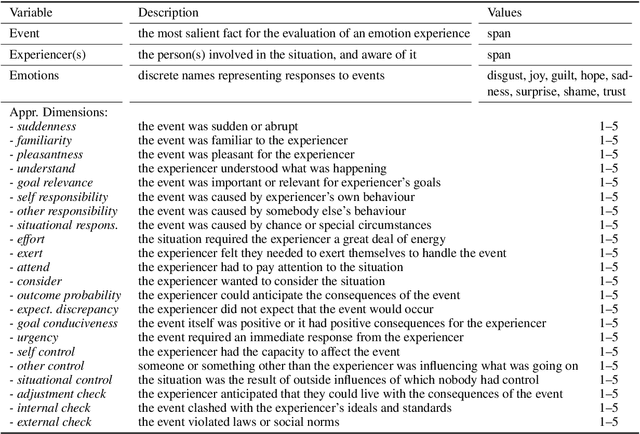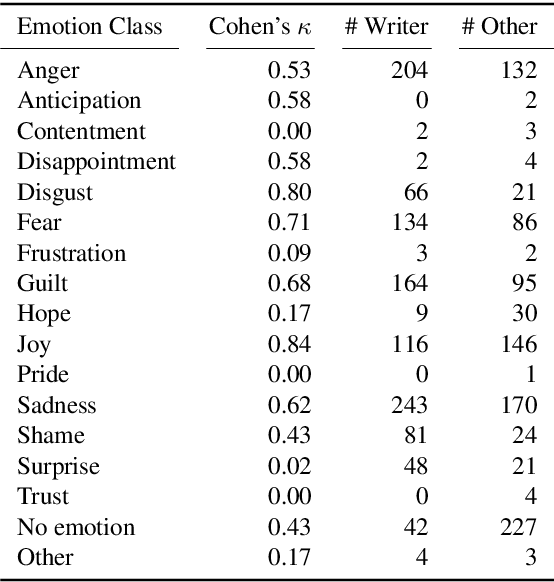Maximilian Wegge
Topic Bias in Emotion Classification
Dec 14, 2023Abstract:Emotion corpora are typically sampled based on keyword/hashtag search or by asking study participants to generate textual instances. In any case, these corpora are not uniform samples representing the entirety of a domain. We hypothesize that this practice of data acquisition leads to unrealistic correlations between overrepresented topics in these corpora that harm the generalizability of models. Such topic bias could lead to wrong predictions for instances like "I organized the service for my aunt's funeral." when funeral events are over-represented for instances labeled with sadness, despite the emotion of pride being more appropriate here. In this paper, we study this topic bias both from the data and the modeling perspective. We first label a set of emotion corpora automatically via topic modeling and show that emotions in fact correlate with specific topics. Further, we see that emotion classifiers are confounded by such topics. Finally, we show that the established debiasing method of adversarial correction via gradient reversal mitigates the issue. Our work points out issues with existing emotion corpora and that more representative resources are required for fair evaluation of models predicting affective concepts from text.
Automatic Emotion Experiencer Recognition
Jun 01, 2023Abstract:The most prominent subtask in emotion analysis is emotion classification; to assign a category to a textual unit, for instance a social media post. Many research questions from the social sciences do, however, not only require the detection of the emotion of an author of a post but to understand who is ascribed an emotion in text. This task is tackled by emotion role labeling which aims at extracting who is described in text to experience an emotion, why, and towards whom. This could, however, be considered overly sophisticated if the main question to answer is who feels which emotion. A targeted approach for such setup is to classify emotion experiencer mentions (aka "emoters") regarding the emotion they presumably perceive. This task is similar to named entity recognition of person names with the difference that not every mentioned entity name is an emoter. While, very recently, data with emoter annotations has been made available, no experiments have yet been performed to detect such mentions. With this paper, we provide baseline experiments to understand how challenging the task is. We further evaluate the impact on experiencer-specific emotion categorization and appraisal detection in a pipeline, when gold mentions are not available. We show that experiencer detection in text is a challenging task, with a precision of .82 and a recall of .56 (F1 =.66). These results motivate future work of jointly modeling emoter spans and emotion/appraisal predictions.
x-enVENT: A Corpus of Event Descriptions with Experiencer-specific Emotion and Appraisal Annotations
Apr 08, 2022



Abstract:Emotion classification is often formulated as the task to categorize texts into a predefined set of emotion classes. So far, this task has been the recognition of the emotion of writers and readers, as well as that of entities mentioned in the text. We argue that a classification setup for emotion analysis should be performed in an integrated manner, including the different semantic roles that participate in an emotion episode. Based on appraisal theories in psychology, which treat emotions as reactions to events, we compile an English corpus of written event descriptions. The descriptions depict emotion-eliciting circumstances, and they contain mentions of people who responded emotionally. We annotate all experiencers, including the original author, with the emotions they likely felt. In addition, we link them to the event they found salient (which can be different for different experiencers in a text) by annotating event properties, or appraisals (e.g., the perceived event undesirability, the uncertainty of its outcome). Our analysis reveals patterns in the co-occurrence of people's emotions in interaction. Hence, this richly-annotated resource provides useful data to study emotions and event evaluations from the perspective of different roles, and it enables the development of experiencer-specific emotion and appraisal classification systems.
 Add to Chrome
Add to Chrome Add to Firefox
Add to Firefox Add to Edge
Add to Edge